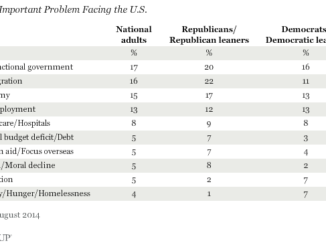
by William H. Frey
President Trump’s pronouncement that the U.S. is “full” and that there is no need for attracting future immigrants is exactly the opposite of what our demographic future portends. If anything, the nation is sputtering from historic demographic stagnation. We recently registered the slowest national growth rate in 80 years due to declining natural increase—as births lower and deaths rise. In the near future, we will become increasingly dependent on immigration and racial minorities— particularly young first and second generation Hispanic and Asian Americans—to infuse growth and vitality into our population and our economy.
Census projections make clear that during the first half of the 21st century, our population growth will diminish: there will be less than half the growth in 2040-50 than in 2000-2010 (Figure 1). This decline would occur even more quickly were it not for immigration, which, if it continues at recent levels, will account for most of our national growth after 2030.

This growth slowdown is driven heavily by the aging of our population and an increased mortality rate. As Figure 2 illustrates, the only part of our population that will continue to grow substantially will be the senior population, aged 65 and above, as it subsumes the large baby boom population. Already this decade, seniors will have grown by nearly 40 percent, to be followed by 30 percent more growth in the 2020s. We are headed toward higher age dependency; a stark contrast from the last half of the 20th century when child dependency was more salient. By 2035, there will be more seniors than children for the first time in the nation’s history.

In fact, projections show that we will register an absolute decline in the population under the age of 18 in in the decade about to end, with only modest growth in our child (17 and under) and labor force aged (18-64 year old) populations in the decades ahead. This is already occurring in large swaths of the nation’s heartland.
As we move forward in time, the primary source of gains in our national population and especially in our slow growing youthful populations will be racial minorities—particularly “new minorities”: Hispanics, Asian Americans, and persons who self-identify as multiracial—a plurality of whom will be first and second generation Americans. As Figure 3 indicates, these groups will double or triple in size between 2015 and 2060, while African Americans, American Indians, and Alaska Natives will also grow, though more modestly.

Especially noteworthy is the fact that the white population is projected to decline over this period. This decline has already occurred for whites under the age of 18 since 2000 and my analysis of census projections show the decline will continue for whites in their 20s and 30s in the two decades ahead. Only whites over age 65 show significant projected growth. This means that all of the growth in the nation’s youth and tepidly growing labor force population will come from racial minorities and particularly new minorities.
All of the growth in the nation’s youth and tepidly growing labor force population will come from racial minorities and particularly new minorities.
The picture being painted for the upcoming decades is one of a rapidly growing largely white native born senior population, that is becoming dependent on a more slow growing and increasingly diverse child and labor force aged population (Figure 4). The 2020 census will show that a majority of the under-18 population will identify with races other than white. This will especially be the case for the 18-29 year old labor force aged population in 2030 (Figure 5).


Clearly, the nation’s modestly growing child and labor force populations are not close to being “full” as President Trump asserts. To the extent they will be growing at all—and, in fact enable us to avoid the “extreme aging” occurring in Japan, Italy and other European countries—is largely attributable to recent decades’ immigration from Latin America, Asia, and elsewhere. Further, U.S. Census Bureau projections assume that their modest growth will only occur if immigration continues.
The president’s proclamation that America is “full” is undoubtedly designed to appeal to his older, native-born demographic base in a continued attempt to convince them that their economic shortfalls can be blamed on immigrants. Ironically, much of this base will be more dependent than ever before on immigrants and their children. This means maintaining a welcoming stance toward immigrants. It also means ensuring that present and future immigrant origin generations be given educational and other opportunities to become successful contributors to the labor force as well as to senior assistance programs, like Social Security and Medicare, as the nation’s age dependency rises. Lastly, it means focusing less on pitting groups against each other and more on remembering our nation’s shared, storied history of immigration.
William H. Frey is a Senior Fellow at Brookings Metropolitan Policy Program. William H. Frey is an internationally regarded demographer, known for his research on urban populations, migration, immigration, race, aging, political demographics and his expertise on the U.S. Census. His latest book is “Diversity Explosion: How New Racial Demographics are Remaking America.”



